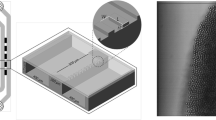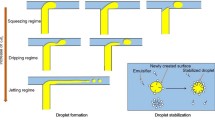Abstract
The Liquid–liquid dispersion process is experimentally investigated to manufacture oil-in-water emulsion working at high flowrates in the cross-slot type of microfluidics. Two cross layouts, namely symmetric and asymmetric configurations, are compared via characterizing the droplet size and size distribution. Automated granulometry is implemented on the images taken by microscopy observations of the emulsion samples. High-speed shadow photography is carried out to discover the continuous- and dispersed-phase flow interactions in the vicinity of the collision region. The results show that the designed microsystems present great potential in terms of fabricating fine oil droplets distributed in the final emulsion. The arithmetic averaged diameter is less than 10 μm at all tested flow conditions and the minimum mean diameter reaches 3.9 μm at the highest energy consumption case. Because of the higher shear stress and more intensified interaction, the symmetric geometry of the cross-slot is beneficial to create fewer amounts of large droplets and dispersing the oil phase more uniformly at the same hydrodynamic conditions, especially in the low Reynolds flow case in this study. As the flowrate is enhanced, the disparity between them is diminished due to the instability inside the channel reaching a high level. The mean drop diameter for both systems is capable to be scaled with the emulsion velocity-based Weber number. The detrimental effect of the symmetric configuration is that the energy required to burst the dispersed streams is relatively a little higher than with asymmetric one.





















Similar content being viewed by others
Availability of data and material
Not applicable.
Code availability
Not applicable.
Abbreviations
- D :
-
Diameter of the droplet (μm)
- D 10 :
-
Arithmetic mean diameter (μm)
- D 32 :
-
Sauter mean diameter (μm)
- D h_d :
-
Hydrodynamic diameter of dispersed channel (μm)
- D max :
-
Maximum droplet diameter (μm)
- f :
-
Oil-to-water volume ratio (–)
- \(\dot{m}\) :
-
Mass flow rate (kg/s)
- PL :
-
Laplace pressure (bar)
- P :
-
Pressure (bar)
- R :
-
Radius of the droplet (μm)
- S p :
-
Specific surface area (μm−1)
- \(\dot{V}\) :
-
Volume flow rate (mL/min)
- U :
-
Superficial velocity (m/s)
- \(\gamma\) :
-
Surface tension (mN/m)
- \(\delta\) :
-
Standard deviation (–)
- μ :
-
Dynamic viscosity (mPa s)
- ϑ :
-
Kinematic viscosity (m2/s)
- ρ :
-
Density (kg/m3)
- σ :
-
Interfacial tension (mN/m)
- \({\varphi }_{d}\) :
-
Oil volume fraction in the emulsion (mN/m)
- \(\tau_{s}\) :
-
Shear stress (bar)
- c:
-
Continuous phase (water)
- d:
-
Dispersed phase (oil)
- e:
-
Emulsion
- Ca :
-
Capillary number (–)
- c.d.f :
-
Cumulative distribution function (–)
- p.d.f :
-
Probability distribution function (–)
- PdI:
-
Polydispersity index (–)
- Re :
-
Reynolds number (–)
- We :
-
Weber number (–)
References
Abismail B, Canselier JP, Wilhelm AM, Delmas H, Gourdon C (1999) Emulsification by ultrasound: drop size distribution and stability. Ultrason Sonochem 6:75–83
Ait Mouheb N, Montillet A, Solliec C, Havlica J, Legentilhomme P, Comiti J, Tihon J (2011) Flow characterization in T-shaped and cross-shaped micromixers. Microfluid Nanofluid 20:1185–1197
Anna SL, Bontoux N, Stone HA (2003) Formation of dispersions using “flow focusing” in microchannels. Appl Phys Lett 82:364–366
Belkadi A, Tarlet D, Montillet A, Bellettre J, Massoli P (2016) Study of two impinging flow microsystems arranged in series. Appl Emuls Biofuel Prod Fuel 170:185–196
Belkadi A, Montillet A, Bellettre J (2018) Biofuel emulsifier using high-velocity impinging flows and singularities in microchannels. J Energ Resour Technol 140:012202
Bellettre J, Belkadi A, Montillet A (2017) https://bases-brevets.inpi.fr/fr/document/WO2017103498.html
Bothe D, Stemich D, Warnecke HJ (2006) Fluid mixing in a T-shaped micro-mixer. Chem Eng Sci 61:2950–2958
Chen HT, Middleman S (1967) Drop size distribution in agitated liquid-liquid systems. AIChE J 13:989–995
Cohen C, Giles R, Sergeyeva V, Mittal N, Tabeling P, Zerrouki D, Baudry J, Bibette J, Bremond N (2014) Parallelised production of fine and calibrated emulsions by coupling flow-focusing technique and partial wetting phenomenon. Microfluid Nanofluid 17:959–966
Cramer C, Fischer P, Windhab EJ (2004) Drop formation in a co-flowing ambient fluid. Chem Eng Sci 59:3045–3058
Davies JT (1985) Drop sizes of emulsions related to turbulent energy dissipation rates. Chem Eng Sci 40:839–842
Galus S, Kadzińska J (2015) Food applications of emulsion-based edible films and coatings. Trends Food Sci Technol 45:273–283
Habchi C, Lemenand T, Della Valle D, Peerhossani H (2009) Liquid/liquid dispersion in a chaotic advection flow. Int J Multiphase Flow 35:485–497
Ji Y, Bellettre J, Montillet A, Massoli P (2021) Experimental investigation on single drop breakage in two-stream impinging microchannels. Exp Fluids 62:17
Ji Y, Bellettre J, Montillet A, Massoli P (2020) Fast oil-in-water emulsification in microchannel using head-on impinging configuration: Effect of swirl motion. Int J Multiphase Flow 131:103402
Kiljański T (2004) Preparation of emulsions using imping streams. AIChE J 50:1636–1639
Kilpatrick PK (2012) Water-in-crude oil emulsion stabilization: review and unanswered questions. Energy Fuels 26:4017–4026
Kobayashi I, Takano T, Meada R, Wada Y, Uemura K, Nakajima M (2008) Straight-through microchannel devices for generating monodisperse emulsion droplets several microns in size. Microfluid Nanofluid 4:167–177
Kolmogorov AN (1949) On the breakage of drops in a turbulent flow. Dokl Akad Nauk SSSR 66:825–828
Lawrence MJ, Rees GD (2000) Microemulsion-based media as novel drug delivery systems. Adv Drug Deliv Rev 45:89–121
Lemenand T, Della Valle D, Zellouf Y, Peerhossaini H (2003) Droplets formation in turbulent mixing of two immiscible fluids in a new type of static mixer. Int J Multiphase Flow 29:813–840
Lemenand T, Habchi C, Della Valle D, Bellettre J, Peerhossaini H (2014) Mass Transfer and emulsification by chaotic advection. Int J Heat Mass Transf 71:228–235
Luo J, Chu G, Luo Y, Zou H, Li G, Chen J (2017) Experimental investigations of liquid-liquid dispersion in a novel helical tube reactor. Chem Eng Process 117:162–170
Mahajan AJ, Kirwan DJ (1996) Micromixing effects in a two-impinging-jets precipitator. AIChE J 42:1802–1814
Marchitto L, Calabria R, Tornatore C, Bellettre J, Massoli P, Montillet A, Valentino G (2018) Optical investigations in a CI engine fueled with water in diesel emulsion produced through microchannels. Exp Therm Fluid Sci 95:96–103
Moreira A, Carneiro J, Campos JBLM, Miranda JM (2021) Production of hydrogel microparticles in microfluidic devices : a review. Microfluid Nanofluid 25:10
Nakashima T, Shimizu M (1988) Advanced inorganic separative membranes and their new developments. Chem Eng Symp Ser 21:93
Paquin P (1999) Technological properties of high pressure homogenizers: the effect of fat globules, milk proteins, and polysaccharides. Int Dairy J 9:329–335
Perro A, Nicolet C, Angly J, Lecomandoux S, le Meins JF, Colin A (2011) Mastering a double emulsion in a simple co-flow microfluidic to generate complex polymersomes. Langmuir 27:9034–9042
Rayleigh L (1878) On the instability of jets. Proc Lond Math Soc 10:4–13
Schlender M, Spengler A, Schuchmann HP (2015) High pressure emulsion formation in cylindrical coaxial orifices: influence of cavitation induced pattern on oil drop size. Int J Multiphase Flow 74:84–95
Siddiqui SW (2014) The effects of oils, low molecular weight emulsifiers and hydrodynamics on oil-in-water emulsification in confined impinging jet mixer. Colloids Surf A Physicochemical Eng Asp 443:8–18
Siddiqui SW, Norton IT (2012) Oil-in-water emulsification using confined impinging jets. J Colloid Interface Sci 337:213–221
Solsvik J, Jakobsen HA (2015) Single drop breakup experiments in stirred liquid-liquid tank. Chem Eng Sci 131:219–234
Taha A, Ahmed E, Ismaiel A, Ashokkumar M, Xu X, Pan S, Hu H (2020) Ultrasonic emulsification: an overview on the preparation of different emulsifiers-stabilized emulsions. Trends Food Sci Technol 105:363–377
Tamir A, Sobhi S (1985) A new two-impinging-streams emulsifier. AIChE J 31:2089–2092
Tan YC, Cristini V, Lee AP (2006) Monodispersed microfluidic droplet generation by shear focusing microfluidic device. Sen Actuators B Chem 114:350–356
Taylor GI (1932) The viscosity of a fluid containing small drops of another fluid. Proc Roy Soc 138:41–48
Theron F, Le Sauze N (2011) Comparison between three static mixers for emulsification in turbulent flow. Int J Multiphase Flow 37:488–500
Thorsen T, Roberts RW, Arnold FH, Quake SR (2001) Dynamic pattern formation in a vesicle-generating microfluidic device. Phys Rev Lett 86:4163–4166
Tsaoulidis D, Angeli P (2017) Liquid-liquid dispersions in intensified impinging-jets cells. Chem Eng Sci 171:149–159
Ushikubo FY, Birribilli FS, Oliveira DRB, Cunha RL (2014) Y- AND T-junction microfluidic devices: effect of fluids and interface properties and operating conditions. Microfluid Nanofluid 17:711–720
Vladisavljević GT, Kobayashi I, Nakajima M (2012) Production of uniform droplets using membrane, microchannel and microfluidic emulsification devices. Microfluid Nanofluid 13:151–178
You JB, Choi Y, Im SG (2017) Influence of adjusting the inlet channel confluence angle on mixing behavior in inertial microfluidic mixers. Microfluid Nanofluid 21:121
Zhao CX, Middelberg APJ (2011) Two-phase microfluidic flows. Chem Eng Sci 66:1394–1411
Zhu P, Wang L (2017) Passive and active droplet generation with microfluidics: a review. Lab Chip 17:34–75
Funding
Région Pays de la Loire (Chaire “Connect Talent”) on Optical Diagnostics for Energy.
Author information
Authors and Affiliations
Contributions
YJ: Formal analysis and investigation, Writing original draft; JB: Conceptualization, Project administration, Funding acquisition, Supervision; AM: Conceptualization, Formal analysis, Validation; PM: Methodology, Funding acquisition, Supervision.
Corresponding author
Ethics declarations
Conflict of interest
Not applicable.
Additional information
Publisher's Note
Springer Nature remains neutral with regard to jurisdictional claims in published maps and institutional affiliations.
Appendix
Appendix
Summarized experimental results (Table 3).
Rights and permissions
About this article
Cite this article
Ji, Y., Bellettre, J., Montillet, A. et al. Effect of cross-slot configuration in microfluidics on o/w emulsification at high throughput. Microfluid Nanofluid 25, 85 (2021). https://doi.org/10.1007/s10404-021-02486-z
Received:
Accepted:
Published:
DOI: https://doi.org/10.1007/s10404-021-02486-z




